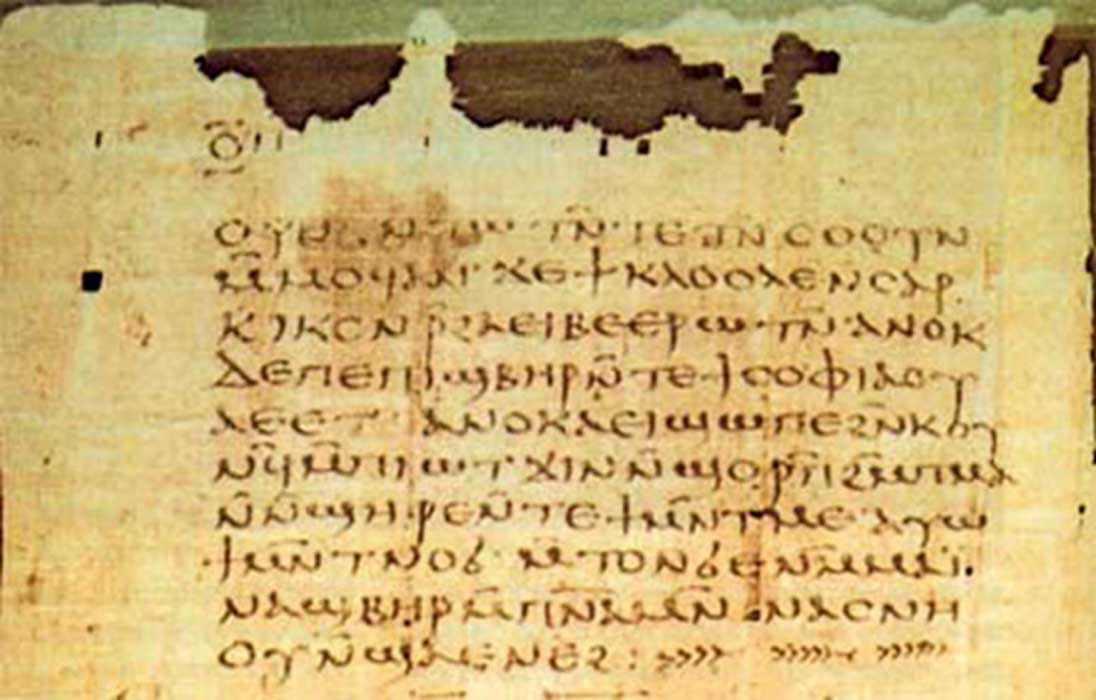Professors Find Original Greek Copy of Jesus’ Teachings to James
Two biblical scholars from the University of Texas at Austin claim to have discovered the first-known original Greek copy of a heretical Christian writing that describes the secret teachings of Jesus to his brother James.
More Heretical Christian Texts Written in Greek Discovered
The University of Texas reports that the 1,600 years old script is part of the Nag Hammadi library, a collection of 13 religious manuscripts originally written in Greek and then translated into Coptic script sometime between the 2nd and 6th Century AD. Wrapped in velum, the original documents are of a heretical tradition known as Gnosticism, an early mysterious form of Christianity.
Earlier in 2017, UT Austin religious studies scholars Geoffrey Smith and Brent Landau added to this mysterious list many more 5 th or 6 th century Greek fragments of the “First Apocalypse of James,” which was considered to have been conserved only in its Coptic translations until now.
The fragments of text were discovered amongst the Egypt Exploration Society archives at kept at the University of Oxford.
“To say that we were excited once we realized what we’d found is an understatement. We never suspected that Greek fragments of the First Apocalypse of James survived from antiquity. But there they were, right in front of us,” an ecstatic with the discovery Smith said as University of Texas reports.

Geoffrey Smith (left) and Brent Landau take a closer look at the Greek fragment identified as the First Apocalypse of James. (Image: Geoffrey Smith, University of Texas, Austin)
The Nag Hammadi Library
The Nag Hammadi Library, a collection of 13 ancient books (called "codices") containing over 50 texts, was discovered in Upper Egypt in 1945. This vastly important discovery includes a large number of primary "Gnostic Gospels" – texts once thought to have been entirely destroyed during the early Christian struggle to define "orthodoxy" – scriptures such as the Gospel of Thomas, the Gospel of Philip, and the Gospel of Truth. The discovery and translation of the Nag Hammadi library, initially completed in the 1970's, has provided impetus to a major re-evaluation of early Christian history and the nature of Gnosticism.
- Researchers extract Papyrus Text from Mummy Mask, revealing what might be the oldest known Gospel
- Ancient Coptic text revealed to be divination tool for predicting the future
- The Most Precious Biblical Artifacts of All Time – But Are They Real?

Yale Papyrus Fragment from the Nag Hammadi Gnostic Library Codex III, containing The Dialogue of the Savior (Yale Beinecke Library). (Public Domain)
They are technically heretical as they fall outside Christianity's canonical boundaries set by Athanasius, Bishop of Alexandria in the 3 rd Century AD. In his “Easter letter of 367,” Athanasius defined the 27-book New Testament: “No one may add to them, and nothing may be taken away from them.” Real records and copies are currently kept at Oxford University.
Controversial Text Tells Us About Jesus’ Brother
Fragments of the controversial text describe how Jesus passes on knowledge of heaven and future events, including his brother’s death. The text, refers to James as Jesus' brother, though “not materially.” Smith explains, “The text supplements the biblical account of Jesus’ life and ministry by allowing us access to conversations that purportedly took place between Jesus and his brother, James — secret teachings that allowed James to be a good teacher after Jesus’ death,” via The University of Texas.
However, the manuscript of ancient alternative Christian teachings was deemed “forbidden” and the two books of the “Apocalypse of James” were rejected when the Emperor Constantine instructed his bishops to standardize the ascendant Christian religion.
- Transcription of ancient manuscript suggests Jesus married Mary Magdalene and had two children
- The origins of the ancient Coptic Church of Egypt
- Did Jesus Have a Wife? New Tests on Ancient Coptic Papyrus May Give Answers
Original Manuscript Served as a Teacher’s Tool
The original manuscript was probably a teacher's modeling tool used to help students learn to read and write in Greek. The researchers believe that the text's delicate, uniform handwriting, as well as its words being separated into syllables, indicates that it was used by an academic. “The scribe has divided most of the text into syllables by using mid-dots. Such divisions are very uncommon in ancient manuscripts, but they do show up frequently in manuscripts that were used in educational contexts,” said Landau via The University of Texas. And added, “The teacher who produced this manuscript must have 'had a particular affinity for the text.” Furthermore, it does not appear to be a brief excerpt from the text, as was common in school exercises, but rather a complete copy of this forbidden ancient writing.
The discovery was announced by Smith and Landau at the Society of Biblical Literature Annual Meeting in Boston in November.
Top image: Fragment of Apocalypse of Peter, part of the Nag-Hammadi-Codex found in Egypt. (Public Domain)

















